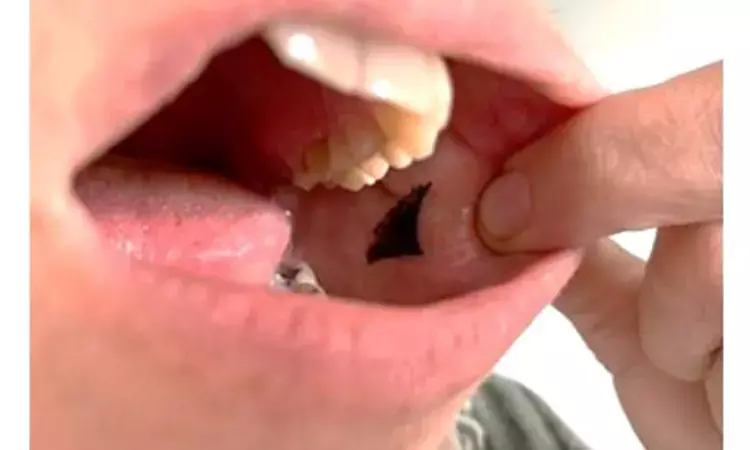- Home
- Medical news & Guidelines
- Anesthesiology
- Cardiology and CTVS
- Critical Care
- Dentistry
- Dermatology
- Diabetes and Endocrinology
- ENT
- Gastroenterology
- Medicine
- Nephrology
- Neurology
- Obstretics-Gynaecology
- Oncology
- Ophthalmology
- Orthopaedics
- Pediatrics-Neonatology
- Psychiatry
- Pulmonology
- Radiology
- Surgery
- Urology
- Laboratory Medicine
- Diet
- Nursing
- Paramedical
- Physiotherapy
- Health news
- Fact Check
- Bone Health Fact Check
- Brain Health Fact Check
- Cancer Related Fact Check
- Child Care Fact Check
- Dental and oral health fact check
- Diabetes and metabolic health fact check
- Diet and Nutrition Fact Check
- Eye and ENT Care Fact Check
- Fitness fact check
- Gut health fact check
- Heart health fact check
- Kidney health fact check
- Medical education fact check
- Men's health fact check
- Respiratory fact check
- Skin and hair care fact check
- Vaccine and Immunization fact check
- Women's health fact check
- AYUSH
- State News
- Andaman and Nicobar Islands
- Andhra Pradesh
- Arunachal Pradesh
- Assam
- Bihar
- Chandigarh
- Chattisgarh
- Dadra and Nagar Haveli
- Daman and Diu
- Delhi
- Goa
- Gujarat
- Haryana
- Himachal Pradesh
- Jammu & Kashmir
- Jharkhand
- Karnataka
- Kerala
- Ladakh
- Lakshadweep
- Madhya Pradesh
- Maharashtra
- Manipur
- Meghalaya
- Mizoram
- Nagaland
- Odisha
- Puducherry
- Punjab
- Rajasthan
- Sikkim
- Tamil Nadu
- Telangana
- Tripura
- Uttar Pradesh
- Uttrakhand
- West Bengal
- Medical Education
- Industry
New insulin patch that sticks inside a person's cheek

Managing blood sugar levels requires round-the-clock attention for people diagnosed with diabetes. A more healthful diet and increased physical activity can help, but many with the condition also need to take regular shots of insulin — the primary hormone that regulates sugar. To deliver this drug in a less invasive way, researchers in ACS Applied Bio Materials now report a prototype insulin-loaded patch that comfortably sticks to the inside of a person's cheek.
According to the American Diabetes Association, approximately 6 million Americans use insulin to help control their diabetes, either because their bodies don't make the hormone (Type 1) or don't respond well to what they do make (Type 2). People primarily take insulin by injecting themselves with pens or syringes, or they have semi-permanent pumps implanted. These methods are invasive and uncomfortable, and they require safe needle or biohazard disposal and sterile conditions. Researchers have explored other ways to deliver insulin through the skin, such as gel-like lotions. But the skin is too good of a barrier, and drugs move into the body slowly. In contrast, the membrane lining the inside of the mouth is very thin, about one quarter the thickness of skin, making it a potential place for drugs to easily enter the bloodstream. So, Sabine Szunerits and colleagues wanted to see if a material they had previously developed — a polymer fiber mat that is activated by heat to release drugs — could attach to the cheek's lining and deliver insulin.
The researchers first soaked small squares of a nanofiber mat, made from electrospun fibers of poly(acrylic acid), β-cyclodextrin and reduced graphene oxide, in a solution with insulin for three hours. Then the team applied the insulin-loaded patches onto cheek linings and corneas from pigs. Heating the material with a near-infrared laser for 10 minutes to 122F activated the material and released insulin into the two types of membranes several times faster than through skin. In addition, the researchers placed the patches in vivo inside the cheeks of three insulin-dependent pigs. The cheek linings showed no irritation or visual changes from the laser's heat. As soon as the material was activated, the pigs' blood sugar levels declined. Simultaneously, the animals' plasma insulin levels increased, which the researchers say is proof-of-concept that this preliminary platform is efficient at getting insulin into the bloodstream. Finally, six human volunteers placed a placebo version of the patch inside their cheeks, saying that it felt comfortable over a two-hour period. The researchers say their next step is to conduct further preclinical studies of the prototype on animal models.
The authors acknowledge funding from Centre National de la Recherche Scientifique (CNRS) of France, the University of Lille, the i-SITE foundation of the University of Lille, the Hauts-de-France region, the CPER "Photonics for Society" and the European Union's Horizon 2020 Research and Innovation Staff Exchange (RISE) Marie Skłodowska-Curie Actions.
https://pubs.acs.org/doi/10.1021/acsabm.1c01161
Hina Zahid Joined Medical Dialogue in 2017 with a passion to work as a Reporter. She coordinates with various national and international journals and association and covers all the stories related to Medical guidelines, Medical Journals, rare medical surgeries as well as all the updates in the medical field. Email: editorial@medicaldialogues.in. Contact no. 011-43720751
Dr Kamal Kant Kohli-MBBS, DTCD- a chest specialist with more than 30 years of practice and a flair for writing clinical articles, Dr Kamal Kant Kohli joined Medical Dialogues as a Chief Editor of Medical News. Besides writing articles, as an editor, he proofreads and verifies all the medical content published on Medical Dialogues including those coming from journals, studies,medical conferences,guidelines etc. Email: drkohli@medicaldialogues.in. Contact no. 011-43720751


